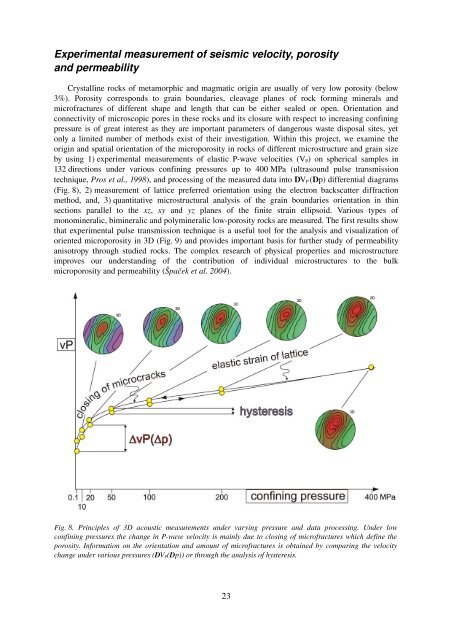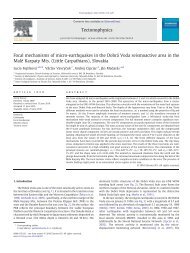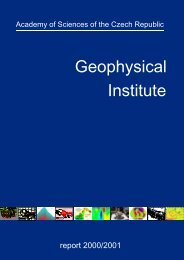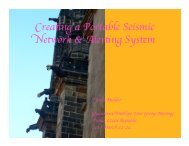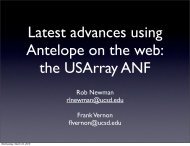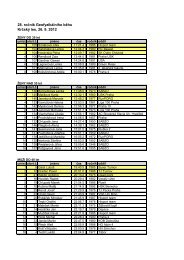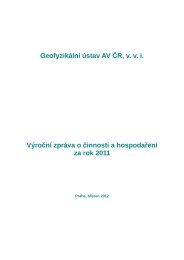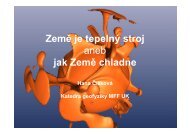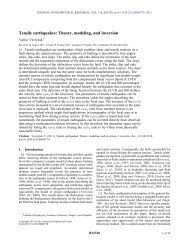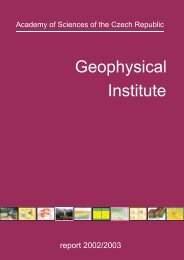Geophysical Institute of the ASCR
Geophysical Institute of the ASCR
Geophysical Institute of the ASCR
Create successful ePaper yourself
Turn your PDF publications into a flip-book with our unique Google optimized e-Paper software.
Experimental measurement <strong>of</strong> seismic velocity, porosity<br />
and permeability<br />
Crystalline rocks <strong>of</strong> metamorphic and magmatic origin are usually <strong>of</strong> very low porosity (below<br />
3%). Porosity corresponds to grain boundaries, cleavage planes <strong>of</strong> rock forming minerals and<br />
micr<strong>of</strong>ractures <strong>of</strong> different shape and length that can be ei<strong>the</strong>r sealed or open. Orientation and<br />
connectivity <strong>of</strong> microscopic pores in <strong>the</strong>se rocks and its closure with respect to increasing confining<br />
pressure is <strong>of</strong> great interest as <strong>the</strong>y are important parameters <strong>of</strong> dangerous waste disposal sites, yet<br />
only a limited number <strong>of</strong> methods exist <strong>of</strong> <strong>the</strong>ir investigation. Within this project, we examine <strong>the</strong><br />
origin and spatial orientation <strong>of</strong> <strong>the</strong> microporosity in rocks <strong>of</strong> different microstructure and grain size<br />
by using 1) experimental measurements <strong>of</strong> elastic P-wave velocities (V P ) on spherical samples in<br />
132 directions under various confining pressures up to 400 MPa (ultrasound pulse transmission<br />
technique, Pros et al., 1998), and processing <strong>of</strong> <strong>the</strong> measured data into DV P (Dp) differential diagrams<br />
(Fig. 8), 2) measurement <strong>of</strong> lattice preferred orientation using <strong>the</strong> electron backscatter diffraction<br />
method, and, 3) quantitative microstructural analysis <strong>of</strong> <strong>the</strong> grain boundaries orientation in thin<br />
sections parallel to <strong>the</strong> xz, xy and yz planes <strong>of</strong> <strong>the</strong> finite strain ellipsoid. Various types <strong>of</strong><br />
monomineralic, bimineralic and polymineralic low-porosity rocks are measured. The first results show<br />
that experimental pulse transmission technique is a useful tool for <strong>the</strong> analysis and visualization <strong>of</strong><br />
oriented microporosity in 3D (Fig. 9) and provides important basis for fur<strong>the</strong>r study <strong>of</strong> permeability<br />
anisotropy through studied rocks. The complex research <strong>of</strong> physical properties and microstructure<br />
improves our understanding <strong>of</strong> <strong>the</strong> contribution <strong>of</strong> individual microstructures to <strong>the</strong> bulk<br />
microporosity and permeability (Špaček et al. 2004).<br />
Fig. 8. Principles <strong>of</strong> 3D acoustic measurements under varying pressure and data processing. Under low<br />
confining pressures <strong>the</strong> change in P-wave velocity is mainly due to closing <strong>of</strong> micr<strong>of</strong>ractures which define <strong>the</strong><br />
porosity. Information on <strong>the</strong> orientation and amount <strong>of</strong> micr<strong>of</strong>ractures is obtained by comparing <strong>the</strong> velocity<br />
change under various pressures (DV P (Dp)) or through <strong>the</strong> analysis <strong>of</strong> hysteresis.<br />
23


